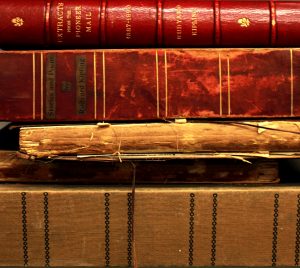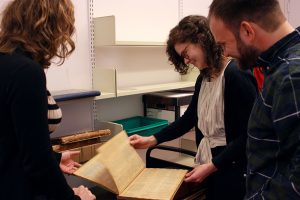by Roger Gillis and Jessica Ruzek
This blog post is the second in a series of blog posts about the Digital Kipling Project. For more information on the project, please check out the first blog post.
Scrapbooking, which may be considered by some a trivial pastime, gives scholars interesting insights. In the case of the Kipling scrapbooks, we can see the works as they were originally printed. This post will focus on the collectors who compiled a selection of works by and about Rudyard Kipling and who chose to arrange these in the form of scrapbooks.
The Digital Kipling Project, an endeavour to digitize and make available these otherwise unseen gems surrounding Kipling’s legacy, got underway in the summer of 2017. Diana Doublet, the Digital Kipling’s Digitization Assistant, carefully digitized the content of a variety of scrapbooks created by several notable nineteenth and twentieth century Kipling enthusiasts: Sir William Garth, Ellis Ames Ballard, G. D. Wells, James Todman Goodwin, and three unidentified collectors.
These scrapbooks, informal and sometimes haphazard compilations of works written by or about Kipling, were acquired by James McGregor Stewart for his prestigious Kipling collection, which was donated to Dalhousie University in 1954. The Kipling Collection shows Stewart’s admiration of Kipling and the legacy Kipling left in the world of literature and culture.
The scrapbooks likewise demonstrate a regard for a figure whose impact was far-reaching in the British Empire and beyond. Not only do they preserve early works of Kipling’s and some of the criticisms and responses to his work during Kipling’s life, but the scrapbooks also reveal something of the scrapbook collectors themselves.
For example, The “Letters of Marque” surrounds Kipling’s early journalistic works for the Anglo-Indian newspaper The Pioneer Mail. These “Letters” are preserved in their entirety, clipped directly from the Pioneer as they were printed from December 14, 1887 to February 28, 1888, and carefully pasted and organized into a handsome leather and paper bound scrapbook.
The scrapbook the letters appear in, titled Extracts from the Pioneer Mail: Being Rudyard Kipling’s Contributions Thereto During the Years 1887-1888, was created by Sir William Garth (1854–1923), a British lawyer and advocate serving in Kolkata from 1885–1913. During Garth’s appointment in India, he became an admirer of Kipling’s writings, and collected newspaper clippings of Kipling’s works and pasted these into his scrapbook.
The digitized scrapbook, along with several others, is now available on Dalspace. In addition, a “Letters of Marque” exhibit will be released this fall as part of the Dalhousie Libraries Digital Exhibit initiative. In this exhibit, not only will each “Letter” be available for viewing, an interactive map will be accessible to view the locations and landmarks Kipling visited in India while writing the “Letters.”
Following Garth’s death in 1923, his impressive collection of arts and letters were sold to Sotheby’s in London where a Philadelphia barrister, Ellis Ames Ballard, acquired the Garth scrapbook. Ballard (1861–1938), also a devotee and collector of Kipling’s works, valued Garth’s scrapbook immensely. In his book, My Kipling Collection, Ballard states: “The Garth Album is of such importance that I have included it in the catalogue proper.” It is presumed that Stewart acquired the Garth scrapbook following Ballard’s death, and entered it into the collection that we have today.
Garth’s scrapbook, as well as the remaining ten scrapbooks compiled by the other seven collectors, are testaments to the nineteenth and twentieth century reading experience. Demonstrating a dedication to preserving ephemeral media, these scrapbooks reveal a time when the average person could curate their own accumulation of information and make sense of the world around them. While this practice may find its equivalent today in the form of bookmarking or hashtagging, the process of scrapbooking is involved in what scrapbook scholar Ellen Gruber Garvey calls, in her book Writing with Scissors: American Scrapbooks from the Civil War to the Harlem Renaissance, “gestures of preservation,” the physical process of reading, flipping, selecting, clipping, organizing, and finally, pasting material into a physical book dedicated to this activity.
Garth’s scrapbook in particular expresses his relationship with Britain, and his admiration for the “Letters’” “globe-trotting Englishman” who represented his nation’s interests. His loyalty to his country is glued into the pages of his scrapbook, effectively curating Kipling’s early writings and Garth’s own sense of national belonging. Had Garth not felt the compulsion to collect these works of Kipling’s, the original format of the “Letters of Marque” may have been lost forever.
A number of the Kipling scrapbooks have now been digitized and are available on Dalspace.


